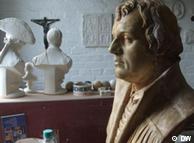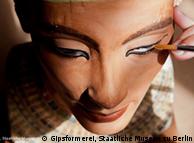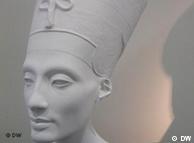Museums | 22.08.2011
Berlin workshop recreates ancient masterpieces
A pale sphinx is sitting on a pillar near the entrance to the atelier. Nearby, on the lawn in front of the brick building, a grim and mighty weather god from Tell Halaf in Syria is peering out of the window on the second floor of the plaster workshop.
Works of art from ancient Greece, Rome, Egypt, from the Middle Ages are collected here, as well as pieces from Africa, Asia, America, and local Berlin sculptors. That's why Miguel Helfrich, the head of the workshop, likes to call it a universal museum.
Its large inventory - about 7,000 replicas - stands close together, in meticulously catalogued rows, over several floors. Some are in glass cabinets, others in deep industrial shelves, and a few are packed onto the staircases.
Each replica reveals the condition that the original piece of art was in when the mould was made, explained workshop manager Bertold Just. Some works damaged after they were duplicated - in World War II or by environmental influences - so the replica serves as a historical record.
 The workshop's repertoire spans millennia
The workshop's repertoire spans millennia
Art with tradition
Since the Berlin workshop has a 200-year tradition, some of the replicas themselves are quite old. German poet Johannes Wolfgang von Goethe (1749-1832) and the scholarly brothers Alexander (1769-1859) and Wilhelm von Humboldt (1767-1835) were customers of the workshop, buying replicas of historic works to decorate their homes.
Even today, the imitations are still created by hand. Valuable alabaster plaster stone is poured into moulds which are traditionally made of silicone or other solid material. As soon as the cast is dry and the casting seams have been removed, the detailed work begins.
Miguel Helfrich says the painters establish a kind of relationship to each object and know exactly where the original was made and how long it had been buried. Their task is to imitate the wounds of time with paint, as well as a wide variety of natural materials, from bronze to rose granite to ivory.
Museums all over the world appreciate buy reproductions from the Berlin workshop, particularly of valuable objects that can't be loaned out or are difficult to transport. Architects also call on the workshop when they want to embellish rooms for prominent clients, as do more and more private customers with a special interest in historical art.
For them, the workshop offers limited editions of two pieces: a bust of Isabella of Aragorn, which exists in its complete form only as a replica, and the legendary Nefertiti.
 Every detail matters
Every detail matters
Time on a brush
For the reproduction of the Nefertiti bust, a new 3D scanner was developed, explained Bertold Just - a method that has so far mainly been used in the auto industry. This scanning process is so exact that "you can really see the thickness of the color, the brightness, the stroke of [Egyptian court sculptor] Thutmose's brush."
Sculpture painter Anette Schulz spends about seven days on each piece, matching blemishes and imitating historical color tones. Achieving Nefertiti's vitality is a particular challenge, said the restorator.
"She appears so true-to-life, and not just painted," exclaimed Schulz. This, of course, has a lot to do with the 3,500 years that have left their traces on Nefertiti's countenance. The signs of her age are applied to the replica as carefully as her eye-liner and eyebrows.
And her famous gaze has to be just right, said Schulz.
So far, she has completed 10 of the 100 Nefertiti replicas planned for the limited edition series. They're nearly identical to the ancient Egyptian herself - except that they are made of plaster, and only cost 2,900 euros ($4,200). That includes a pair of white gloves, so the piece doesn't get dirty when taking it out of the box.
Author: Silke Bartlick / ef
Editor: Kate Bowen

沒有留言:
張貼留言